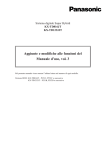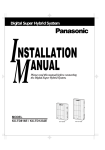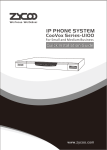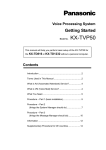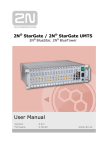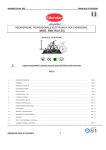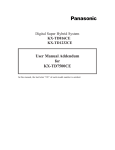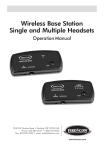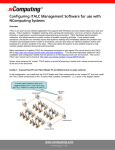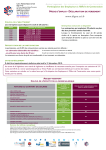Download KX-TD1232JT
Transcript
Digital Super Hybrid System KX-TD816JT KX-TD1232JT Programming Guide for KX-TD7590JT and Programming Guide Addendum for KX-TD816JT/ KX-TD1232JT In this manual, the suffix "JT" of each model number is omitted. Table of Contents 1 DECT Programming ........................................................................ 3 1.1 DECT Programming ..................................................................................................... 4 [020] PS Flexible Button Assignment ................................................................................... 4 [100] Flexible Numbering ..................................................................................................... 6 [109] Expansion Unit Type.................................................................................................... 8 [650] PS Registration........................................................................................................... 10 [651] PS Termination........................................................................................................... 14 [653] PS Extension Name Set ............................................................................................. 16 [654] SXDP Assignment ..................................................................................................... 17 [655] PS Budget Management............................................................................................. 18 [656] PS Charge Verification Assignment........................................................................... 20 [657] PS Class of Service .................................................................................................... 21 [658] PS Extension Group Assignment............................................................................... 23 [659-660] PS DIL 1:N Extension – Day / Night ................................................................. 25 [661-662] PS Outgoing Permitted Outside Line Assignment – Day / Night ...................... 27 [665] PS Voice Mail Access Codes ..................................................................................... 29 [671] PS Extension Number Set .......................................................................................... 31 [672] PS Password Set......................................................................................................... 33 [673] PS CLIP / COLP Number Assignment...................................................................... 34 [676] PS Incoming Call Display.......................................................................................... 35 [680] Cell Station Number Assignment for Master CS....................................................... 36 [681] PS Radio System ID Reference ................................................................................. 37 [682] Radio Information Data Clear.................................................................................... 38 1.2 Programming Tables ................................................................................................... 39 2 Programming Guide Addendum for KX-TD816JT / KX-TD1232JT. 69 2.1 Changed and Added Programming ........................................................................... 70 Introduction ............................................................................................................................ 70 [100] Flexible Numbering ................................................................................................... 70 [127] UCD Time Table........................................................................................................ 70 [216] Message Waiting Ring Interval Time ........................................................................ 70 Default Values......................................................................................................................... 70 [016] DISA / TIE User Codes ............................................................................................. 71 [811] DISA / TIE User Codes ............................................................................................. 73 2.2 Optional Programming ............................................................................................... 75 [990] System Additional Information.................................................................................. 75 [991] COS Additional Information...................................................................................... 80 2 Table of Contents Section 1 DECT Programming DECT Programming 3 1.1 DECT Programming 1.1 [020] DECT Programming PS Flexible Button Assignment Description Used to determine how the flexible CO buttons are used on PSs. Selection • PS registration number: KX-TD816 – 01 through 16 KX-TD1232 – 01 through 64 • Flexible CO button number: 1 through 3 • Button Code (plus parameter, if required) Button Code 0 (Single-CO) 1 (DSS) 2 (One-Touch) 3 (Message Waiting) 4 (FWD/DND) 5 (Save) 6 (Account) 7 (Conference) 82 (Voice Mail Transfer) 83 (Two-Way Record)* 84 (Two-Way Transfer)* (Loop-CO) # (Group-CO) Parameter KX-TD816: 01 through 08 (Outside line number) KX-TD1232: 01 through 54 (Outside line number) 2 through 4 digits (Extension number) 16 digits max. (Telephone number) None None None None None 2 through 4 digits (Voice mail extension number) 2 through 4 digits (Voice mail extension number) 2 through 4 digits (Voice mail extension number) None 1 through 8 (Outside line group number) * Available when the Digital Super Hybrid System is connected to a Digital Proprietary Telephone capable Panasonic Voice Processing System (one that supports digital proprietary telephone integration; e.g.KX-TVP200). Default All PSs – CO 1 = Loop-CO, CO2 and CO3 = Not Stored 4 DECT Programming 1.1 DECT Programming Programming 1. Enter 020. Display: PS TASTOFLESSIB 2. Press NEXT. Display: NUM PS? 3. Enter the PS registration number. You can also keep pressing NEXT until the desired PS registration number is displayed. Display: PT-PGM MODO 4. Press the CO button to be changed. The display shows the button pre-assignment. Display example: URB-01 5. Enter the button code (plus parameter, if required). To change the parameter, press CLEAR and enter the new parameter. 6. Press STORE. 7. To programme another CO button for the same PS, repeat steps 4 through 6. To programme another PS, press SELECT and repeat steps 3 through 6. 8. Press END. Cancelling 1. Perform the same procedures as steps 1 through 4 above. 2. Enter 2. 3. Press STORE. 4. Press END. Conditions None Feature References Button, Flexible DECT Programming 5 1.1 DECT Programming [100] Flexible Numbering Description Assigns the leading digits of extension numbers and feature numbers for system features. In addition to current flexible numbering, a feature number for the Super EXtra Device port (SXDP) can be assigned. Number 86 Feature SXDP Default 48 For other feature numbers, refer to the main Installation Manual. Selection • Selection number: 86 • Feature number: 1 through 3 digits Default 48 Programming 1. Enter 100. Display: NUMERAZ FLESSIB 2. Press NEXT. Display: NUM SELEZ? 3. Enter a selection number. To enter selection number 01, you can also press NEXT. Display example: 01. 1-INT S:1 4. Enter the feature number. To delete the feature number, press CLEAR. To change the current entry, press CLEAR and enter the new number. 5. Press STORE. 6. To program another selection, press NEXT or PREV, or SELECT and the desired selection number. 7. Repeat steps 4 through 6. 8. Press END. 6 DECT Programming 1.1 DECT Programming To remove all the feature numbers except selection numbers (01) through (16) 1st through 16th extension blocks; 1. Enter 100. 2. Press NEXT. 3. Enter 00. Display: CANCELLA TUTTO? 4. Press STORE. 5. Press END. Conditions • Each feature number has one through three digits, consisting of 0 through 9, , and #. • If or # is included in a feature number, dial pulse telephone users cannot access the feature. • Double entry and incompatible combinations are invalid. Valid entry example: 30 and 31, 210 and 211. Invalid entry example: 5 and 5, 30 and 301. • If you delete a feature number, the feature cannot be used by dialling operation. • You can remove all the feature numbers except selections (01) through (16). Feature References Flexible Numbering DECT Programming 7 1.1 DECT Programming [109] Expansion Unit Type Description Assigns the type of expansion units to be used in the Master and Slave Systems. This allows the system to identify the unit in each expansion location. Selection KX-TD816 • Areas 1; 2 = C (4CO) / S1 (2S0) / S2 (6S0) / EM(4E&M) / E (EXT) / D (No Use) KX-TD1232 • Master / Slave • Areas 1; 2; 3 = C (4CO) / S1 (2S0) / S2 (6S0) / S3 (1PRI) / EM (4E&M) / E1 (EXT1) / E2 (EXT2) / D (No Use) (Master system only: S3, E1 and E2 for the KX-TD144 or KX-TD146) Default KX-TD816 – C; E KX-TD1232 – Master and Slave – C; E1; E2 Programming 1. Enter 109. Display: MODULO ESPANS 2. Press NEXT to program Master System. To program "Slave," press NEXT twice. Display example: MASTER: C; E1; E2 3. 4. 5. 6. 7. 8 Keep pressing SELECT until the desired selection is displayed. Press . Keep pressing SELECT until the desired selection is displayed. Repeat steps 4 and 5 until the all the required entries are completed. Press STORE. If only one system is in operation, go to step 8. DECT Programming 1.1 DECT Programming 8. Press NEXT to program Slave System. Display example: SLAVE : C; E1; E2 9. Repeat steps 3 through 7. 10.Press END. Conditions • In case of starting the system for the first time or System Data Clear, the application for location will adapt the practical installation instead of system default setting. • There are two expansion areas on the KX-TD816, areas 1 and 2 from bottom to top. There are three expansion area on the KX-TD1232, areas 1, 2 and 3 from bottom to top. • If the Slave System is out-of-service or in case of KX-TD816, skip the steps 8 and 9. • After changing the setting, to make your setting effective, unplug the system once and plug it in again. Otherwise the previous setting will be maintained. Feature References Module Expansion DECT Programming 9 1.1 DECT Programming [650] PS Registration Description Assigns a registration number and an extension number to each PS. Display PT and the PS whose registration number is to be set are required for this programme. Selection (With a display PT) • PS registration number: KX-TD816 – 01 through 16 KX-TD1232 – 01 through 64 • PS extension number: 2 through 4 digits (With a PS) • DECT system number: 1 through 4 • PS password: 4 digits • System lock password: 4 digits Default All PSs – Not Stored Programming [Registering for the first time] (With a display PT) 1. Enter 650. Display: REGISTRAZIONE PS 2. Press NEXT. Display: NUM PS? 3. Enter the PS registration number. Display example: PS01:NON MEMORIZZATO 4. Enter the PS extension number. Display example: PS01:INT 281 5. Press STORE. Display (If enabled): ESECUZIONE Continue programming from step 6 with a PS within five minutes. Display (If disabled): RIFIUTATO The Cell Station (CS) may not be connected or not working. After connecting the CS or resetting the PBX, wait for at least one minute and try again from the beginning. 10 DECT Programming 1.1 DECT Programming (With a PS) 6. Press the POWER button for a while (about 5 seconds). 7. Press the FUNCTION button. 8. Press the FUNCTION button again. Or Press the UP/DOWN button repeatedly until “PROGRAM” is selected and then press the SELECT button. 9. Press the UP/DOWN button repeatedly until the display below is selected. Display: PRG. INIZIALE 10.Press the SELECT button. 11.Press the UP/DOWN button repeatedly until the display below is selected. Display: REGISTRAZIONE 12.Enter the SELECT button. 13.Press the UP/DOWN button repeatedly until the desired DECT system number is selected. Display example:REGISTRAZIONE DECT-SYS 1 DECT-SYS 2 14.Press the SELECT button. Display example: IMMETTERE CODICE =-------- 15.Enter the PS password. Display example: IMMETTERE CODICE =****---- 16.Press the AUTO/OK button. Display: ESECUZIONE You will hear a confirmation tone and the display changes as follows. Display example: DECT-SYS BLOC. ABILITATA DISAB 17.Enter the UP/DOWN button to select “DISABLE” or “ENABLE” for the System Lock. Display example: DECT-SYS BLOC. ABILITATA DISAB DECT Programming 11 1.1 DECT Programming 18.Press the SELECT button. Display example: (if disabled): SBLOCCATO (if enabled) : IMMETTERE CODICE =---- 19.If you select "ENABLE" in step 17, enter a System Lock password. Display: IMMETTERE CODICE =**** 20.Press the AUTO/OK button. Display: REIMMETT. CODICE =---- 21.Enter the System Lock password again. Display: REIMMETT. CODICE =**** 22.Press the AUTO/OK button. Display: BLOCCATO (With a display PT) 23.To programme another PS, press NEXT or PREV, or SELECT and the desired PS registration number. 24.Repeat steps 4 through 22. 25.Press END. [Re-registering] (e.g. when changing the DECT system) 1. Repeat steps 1 through 8 of the “Registering for the first time” programming. 2. Press the UP/DOWN button repeatedly until the display below is selected. Display: PROGRAM. PS 3. Press the SELECT button. 4. Press the UP/DOWN button repeatedly until the display below is selected. Display: PRG SISTEMA DECT 5. Press the SELECT button. If a System Lock password is registered before, the display below will appear. Display example: DECT-SYS BLOC. PASSWORD =---- 12 DECT Programming 1.1 DECT Programming 6. Enter a System Lock password and press the AUTO/OK button, if required. Display: DECT-SYS BLOC. PASSWORD =**** 7. Go to steps 11 through 25 of the “Registering for the first time” programming. Conditions • You can assign an extension number to each PS also in programme, [671] PS Extension Number Set. • The PS password can be assigned in programme [672] PS Password Set. • One PS must have only one registration number. It is not possible to assign the different registration number for one PS. • If the PS extension number or the PS password is changed after registering, the PS cannot be used until it is registered again in this programme. • After pressing the AUTO/OK button in step 16, do not press END before you hear a confirmation tone, or it may not registered correctly. • To re-assign the PS, which is set the System Lock, to the other DECT system, it is required to cancel the System Lock first in PS Programming, “DECT System Lock Password Set.” • Register the PS from a manager DPT connected only to the master cabinet. Feature References Digital Wireless Connection DECT Programming 13 1.1 DECT Programming [651] PS Termination Description Deletes a stored PS so that it cannot be used in the system. Selection • PS registration number: KX-TD816 – 01 through 16 KX-TD1232 – 01 through 64 Default Not applicable Programming 1. Enter 651. Display: TERMINAZIONE PS 2. Press NEXT. Display: NUM PS? 3. Enter the PS registration number. You can also keep pressing NEXT until the desired PS registration number is displayed. Display example: PS01:INT 281 4. Press STORE. Display: ESECUZIONE The system searches for the PS registration number while "Executing" is blinking, and deletes the registration after it is found. Display example: CANCELLATO 5. To delete another PS, press NEXT or PREV, or SELECT and the desired PS registration number. 6. Repeat steps 3 through 5. 7. Press END. Even if "Rejected" is displayed in step 4 above, you can delete the PS. In this case, Registration Clear on the PS (PS Programming) is required. Display: RIFIUTATO (The PS was not deleted correctly.) The display will show the next example below in a few seconds. Display example: CANCELLARE? 8. Go to Step 7 if you do not want to delete. 9. Press STORE. 14 DECT Programming 1.1 DECT Programming 10.To delete another PS, press NEXT or PREV, or SELECT and the desired PS registration number. 11.Repeat steps 3 through 5. 12.Press END. Conditions • Deleting the same PS registration number from the PS by PS Programming is only necessary when it is deleted after "Rejected" is displayed in this programme. • If a PS registration is terminated in this programme, all the PS assignments and its extension assignments will return to the default settings. If you only want to change the PS, retaining all the assignments, re-enter the replacing PS on the old PS registration number in programme [650] PS Registration. In this case, you should reset the system so that the assignment is activated. Feature References Digital Wireless Connection DECT Programming 15 1.1 DECT Programming [653] PS Extension Name Set Description Assigns names to the PS extension numbers programmed in programme [671] Number Set. PS Extension Selection • PS registration number: KX-TD816 – 01 through 16 KX-TD1232 – 01 through 64 • Name: 10 characters (max.) Default All PSs – Not Stored Programming 1. Enter 653. Display: SET NOME EXT PS 2. Press NEXT. Display: NUM PS? 3. Enter the PS registration number. You can also keep pressing NEXT until the desired PS registration number is displayed. Display example: PS01:NON MEMORIZZATO 4. Enter the name. For entering characters, see Section 1.3 Entering Characters in user manual. To delete the current entry, press CLEAR. To change the current entry, press CLEAR and enter the new name. 5. Press STORE. 6. To programme another PS, press NEXT or PREV, or SELECT and the desired PS registration number. 7. Repeat steps 4 through 6. 8. Press END. Conditions None Feature References Digital Wireless Connection 16 DECT Programming 1.1 DECT Programming [654] SXDP Assignment Description Disables or enables the Super EXtra Device Port (SXDP) feature for wired extensions. Selection • Jack number: KX-TD816 – 01 through 16 (-1 / -2), KX-TD1232 – 01 through 64 (-1 / -2), (-1= first part, -2= second part, =all jacks) • Enable / Disable Default All jacks – Enable Programming 1. Enter 654. Display: ASSEGN.SXDP 2. Press NEXT. Display: NUM JACK? 3. Enter the jack number. To enter jack number 01, you can also press NEXT. To select the second part (-2), press NEXT after entering the jack number. Display example: ABILITATA 4. Keep pressing SELECT until the desired selection is displayed. 5. Press STORE. 6. To programme another jack, press NEXT or PREV, or SELECT and the desired jack number. 7. Repeat steps 4 through 6. 8. Press END. Conditions • After programmed, you must reset your system. • To assign all jacks to one selection, press the the contents programmed for the jack 01. key in step 3. In this case, the display shows Feature References Super EXtra Device Port (SXDP) DECT Programming 17 1.1 DECT Programming [655] PS Budget Management Description Assigns the charge limit for a call on a PS basis. Selection • PS registration number: KX-TD816 – 01 through 16, KX-TD1232 – 01 through 64, ( =all PS registration numbers) • Charge limit (Charge): 0 through 59999 Default All PSs – 0 Programming 1. Enter 655. Display: LIMITE CARICA PS 2. Press NEXT. Display: NUM PS? 3. Enter the PS registration number. You can also keep pressing NEXT until the desired PS registration number is displayed. Display example: PS01: 0 4. Enter a charge limit. To delete the charge limit, press CLEAR. 5. Press STORE. 6. To programme another PS, press NEXT or PREV, or SELECT and the desired PS registration number. 7. Repeat steps 4 through 6. 8. Press END. Conditions • If the charge limit is set "0", no restriction is applied. • To assign all PSs to one selection, press the key in step 3. In this case, the display shows the contents programmed for the PS 01. • The displayed currency denomination can be programmed by programme [121] Assignment of Denomination. 18 DECT Programming 1.1 DECT Programming Feature References Budget Management Charge Fee Reference DECT Programming 19 1.1 DECT Programming [656] PS Charge Verification Assignment Description Assigns the PS which is allowed to refer or clear the charge information on the extension, outside line, department code, account code, and total. Selection • PS registration number: KX-TD816 – 01 through 16, KX-TD1232 – 01 through 64, ( =all PS registration numbers) • Enable / Disable Default All PSs – Enable Programming 1. Enter 656. Display: PS RIF.CARICA 2. Press NEXT. Display: NUM PS? 3. Enter the PS registration number. You can also keep pressing NEXT until the desired PS registration number is displayed. Display example: PS01:ABILITATA 4. Keep pressing SELECT until the desired selection is displayed. 5. Press STORE. 6. To programme another PS, press NEXT or PREV, or SELECT and the desired PS registration number. 7. Press END. Conditions • To assign all PSs to one selection, press the the contents programmed for the PS 01. key in step 3. In this case, the display shows Feature References Charge Fee Reference 20 DECT Programming 1.1 DECT Programming [657] PS Class of Service Description Programmes each PS a Class of Service (COS). The COS determines the call handling abilities for each PS. Primary and secondary COS numbers can be assigned for each PS. Selection • PS registration number: KX-TD816 – 01 through 16, KX-TD1232 – 01 through 64, ( =all PS registration numbers) • COS number: 1 through 8 Default All PSs – Primary / Secondary – COS 1 Programming 1. Enter 657. Display: PS ASS.COS 2. Press NEXT. Display: NUM PS? 3. Enter the PS registration number. You can also keep pressing NEXT until the desired PS registration number is displayed. Display example: PS01:CS1, CS1 4. Enter a primary COS number. To change the current entry, enter the new number. 5. Press . 6. Enter a secondary COS number. To change the current entry, enter the new number. 7. Press STORE. 8. To programme another PS, press NEXT or PREV, or SELECT and the desired PS registration number. 9. Repeat steps 4 through 8. 10.Press END. Conditions • There is a maximum of eight Classes of Service. Every PS must be assigned to a Class of Service and is subject to COS Programming in programmes [500] through [518] and [991]. DECT Programming 21 1.1 DECT Programming • To assign all PSs to one COS, press the contents programmed for the PS 01. key in step 3. In this case, the display shows the Feature References Class of Service (COS) 22 DECT Programming 1.1 DECT Programming [658] PS Extension Group Assignment Description Assigns each PS to an extension group. Extension groups are used for Group Call Pickup. Selection • PS registration number: KX-TD816 – 01 through 16, KX-TD1232 – 01 through 64, ( =all PS registration numbers) • Extension group number: 1 through 8 Default All PSs – Extension group 1 Programming 1. Enter 658. Display: PS GRUPPO EXT 2. Press NEXT. Display: NUM PS? 3. Enter the PS registration number. You can also keep pressing NEXT until the desired PS registration number is displayed. Display example: PS01:EXG01 4. Enter an extension group number. To change the current entry, press CLEAR and enter the new extension group number. 5. Press STORE. 6. To programme another PS, press NEXT or PREV, or SELECT and the desired PS registration number. 7. Repeat steps 4 through 6. 8. Press END. DECT Programming 23 1.1 DECT Programming Conditions • There is a maximum of eight extension groups. Each PS can only belong to one group. • To assign all PSs to one selection, press the the contents programmed for the PS 01. key in step 3. In this case, the display shows Feature References Call Pickup, Group Extension Group 24 DECT Programming 1.1 DECT Programming [659-660] PS DIL 1:N Extension – Day / Night Description A DIL 1:N line can be assigned to call more than one extension. All incoming calls from the programmed outside lines are directed to the specified PSs. This programme assigns the PSs for each outside line in both the day and night modes. Selection • PS registration number: KX-TD816 – 01 through 16 KX-TD1232 – 01 through 64 • Outside line number: KX-TD816 – 01 through 08, KX-TD1232 – 01 through 24, ( =all outside lines) • Enabl (enable) / Disab (disable) Default All PSs – All outside lines – Disable – Day / Night Programming 1. Enter a programme address (659 for day or 660 for night). Display example: PS DIL 1:N G 2. Press NEXT. Display: NUM PS? 3. Enter the PS registration number. You can also keep pressing NEXT until the desired PS registration number is displayed. Display example: PS01:LU01:DISAB 4. Enter the outside line number. You can also keep pressing or until the desired outside line number is displayed. To change the current entry, enter the new number. 5. Keep pressing SELECT until the desired selection is displayed. 6. Press STORE. 7. To programme another PS, press NEXT or PREV, or SELECT and the desired PS registration number. 8. Repeat steps 4 through 7. 9. Press END. DECT Programming 25 1.1 DECT Programming Conditions • To assign all outside lines to “Disable”, press the key in step 4. In this case, the display shows the contents programmed for outside line 01. • When you change the PS registration number by pressing NEXT or PREV, the outside line number will not changed. <Example> PS01:CO06.....Press NEXT.....PS02:CO06 Feature References Direct In Lines (DIL) Night Service 26 DECT Programming 1.1 DECT Programming [661-662] Night PS Outgoing Permitted Outside Line Assignment – Day / Description Determines which outside lines can be accessed by a PS in both the day and night modes. PS users can make outgoing outside calls using the assigned outside lines. Selection • PS registration number: KX-TD816 – 01 through 16, KX-TD1232 – 01 through 64, ( =all PS registration numbers) • Outside line number: KX-TD816 – 01 through 08, KX-TD1232 – 01 through 24, ( =all outside lines) • Enabl (enable) / Disab (disable) Default All PSs – All outside lines – Enable – Day / Night Programming 1. Enter a programme address (661 for day or 662 for night). Display example: PS LU USC G 2. Press NEXT. Display: NUM PS? 3. Enter the PS registration number. You can also keep pressing NEXT until the desired PS registration number is displayed. Display example: PS01:LU01:ABIL 4. Enter the outside line number. You can also keep pressing or until the desired outside line number is displayed. To change the current entry, enter the new number. 5. Keep pressing SELECT until the desired selection is displayed. 6. Press STORE. 7. To programme another PS, press NEXT or PREV, or SELECT and the desired PS registration number. 8. Repeat steps 4 through 7. 9. Press END. DECT Programming 27 1.1 DECT Programming Conditions • To assign all PSs or all outside lines to one selection, press the key in step 3 or 4. In this case, the display shows the contents programmed for outside line 01 or the PS 01. • When you change the PS registration number by pressing NEXT or PREV, the outside line number will not changed. <Example> PS01:CO06.....Press NEXT.....PS02:CO06 Feature References Night Service Outside Line Connection Assignment - Outgoing 28 DECT Programming 1.1 DECT Programming [665] PS Voice Mail Access Codes Description Assigns a mailbox number for each PS only if programme [990] Information, Field (18) , is set to "free." System Additional Selection • PS registration number: KX-TD816 – 01 through 16 KX-TD1232 – 01 through 64 • Mailbox number: 16 digits (max.) Default All PSs – Not Stored Programming 1. Enter 665. Display: PS ID CODE VM 2. Press NEXT. Display: NUM PS? 3. Enter the PS registration number. You can also keep pressing NEXT until the desired PS registration number is displayed. Display example: PS01:NON MEMORIZZATO 4. Enter the mailbox number. To delete the current entry, press CLEAR. To change the current entry, press CLEAR and enter the new number. 5. Press STORE. 6. To programme another PS, press NEXT or PREV, or SELECT and the desired PS registration number. 7. Repeat steps 4 through 6. 8. Press END. Conditions • The system supports a maximum of eight jacks (16 jacks during System Connection) for connection to a Voice Processing System as the Voice Mail or Automated Attendant ports. • Each mailbox number has a maximum of 16 digits, consisting of 0 through 9, PAUSE. DECT Programming , # and 29 1.1 DECT Programming • To display parts of the mailbox number which have scrolled off the display, press or . Feature References Voice Mail Integration for Inband 30 DECT Programming 1.1 DECT Programming [671] PS Extension Number Set Description Assigns an extension number to each PS. Selection • PS registration number: KX-TD816 – 01 through 16 KX-TD1232 – 01 through 64 • PS extension number: 2 through 4 digits Default All PSs – Not Stored Programming 1. Enter 671. Display: PS SET NUM.EXT 2. Press NEXT. Display: NUM PS? 3. Enter the PS registration number. You can also keep pressing NEXT until the desired PS registration number is displayed. Display example: PS01:NON MEMORIZZATO 4. Enter the PS extension number. To delete the current entry, press CLEAR. To change the current entry, press CLEAR and enter the new name. Display example: PS01:INT 281 5. Press STORE. 6. To programme another PS, press NEXT or PREV, or SELECT and the desired PS registration number. 7. Repeat steps 4 through 6. 8. Press END. Conditions • Each PS extension number can be two to four digits, consisting of 0 through 9. The and # keys cannot be used. • A PS extension number can also be assigned in programme [650] PS Registration. • A PS extension number is invalid if the first or second digits do not match with the setting in programme [100] Flexible Numbering, (01) - (16) 1st through 16th hundred extension DECT Programming 31 1.1 DECT Programming blocks. If one digit is assigned as the leading digit, some PS extension numbers have two or three digits. If two digits are assigned, they have three digits and some may have four digits. • Double entries or incompatible entries are invalid including the assignment in programmes [003] Extension Number Set, [012] ISDN Extension Number Set, [127] Voice Mail Extension Number Assignment, [130] Phantom Extension Number Assignment or [813] Floating Number Assignment. Valid entry examples are: 10 and 11; 10 and 110. Invalid entry examples are: 10 and 106; 210 and 21. • Programme [653] PS Extension Name Set, is used to name the PSs. • It is possible to modify the extension number in this programme. If the PS extension number was modified, re-register the PS to the system in programme [650] PS Registration, in order to use the extension number. Feature References Digital Wireless Connection 32 DECT Programming 1.1 DECT Programming [672] PS Password Set Description Assigns a registration password, which is used for registration (programme [100] Numbering), to each PS. Flexible Selection • PS registration number: KX-TD816 – 01 through 16 KX-TD1232 – 01 through 64 • PS password: 4 digits Default All PSs – 1234 Programming 1. Enter 672. Display: PS SET PASSWORD 2. Press NEXT. Display: NUM PS? 3. Enter the PS registration number. You can also keep pressing NEXT until the desired PS registration number is displayed. Display example: PS01:1234 4. Enter the PS password. Display example: PS01:5678 5. Press STORE. 6. To programme another PS, press NEXT or PREV, or SELECT and the desired PS registration number. 7. Repeat steps 4 through 6. 8. Press END. Conditions None Feature References None DECT Programming 33 1.1 DECT Programming [673] PS CLIP / COLP Number Assignment Description Assigns a CLIP / COLP number to each Portable Station. Selection • PS registration number: KX-TD816 – 01 through 16, KX-TD1232 – 01 through 64, =( all PS registration numbers) • CLIP/COLP number: 16 digits (max.) Default All PSs – Not Stored Programming 1. Enter 673. Display: PS CLIP/COLP 2. Press NEXT. Display: NUM PS? 3. Enter the PS registration number. You can also keep pressing NEXT until the desired PS registration number is displayed. Display example: PS01:NON MEMORIZZATO 4. Enter a CLIP / COLP number. To change the current entry, press CLEAR and the new number. 5. Press STORE. 6. To programme another PS, press NEXT or PREV, or SELECT and the desired PS registration number. 7. Repeat steps 3 through 6. 8. Press END. Conditions • Each CLIP / COLP number can be a maximum of 16 digits, consisting of 0 through 9. • To assign all PSs to one selection, press the the contents programmed for the PS 01. key in step 3. In this case, the display shows Feature References Calling / Connected Line Identification Presentation (CLIP / COLP) Calling / Connected Line Identification Restriction (CLIR / COLR) 34 DECT Programming 1.1 DECT Programming [676] PS Incoming Call Display Description Allows you to choose between three display types when an incoming call is received by PS. Calling: The incoming caller's telephone number is displayed. Called: The called telephone number is displayed. Line Name: The outside line name assigned in the [417] programme is displayed. Selection • PS registration number: KX-TD816 – 01 through 16, KX-TD1232 – 01 through 64, ( =all PS registration numbers) • Display Types: Calling / Called / Line name Default All PSs – Calling Programming 1. Enter 676. Display: PS DISPLAY ENTR. 2. Press NEXT. You can also keep pressing NEXT until the desired PS registration number is displayed. Display example: PS01: CHIAMANTE 3. Keep pressing SELECT until the desired selection is displayed. 4. Press STORE. 5. To programme another PS, press NEXT or PREV, or SELECT and the desired PS registration number. 6. Repeat steps 4 through 6. 7. Press END. Conditions • To assign all PSs to one selection, press the key in step 3. In this case, the display shows the contents programmed for the PS 01. • If the receiving call is in the 1:N status, the display only shows outside line number. Feature References Display, Message Incoming Outside Call Information Display DECT Programming 35 1.1 DECT Programming [680] Cell Station Number Assignment for Master CS Description Assigns the cell station number which is used for the master CS. Selection • Cell Station number: KX-TD816 – RIF1 / RIF2 / RIF3 / RIF4 / RIF5 / RIF6 KX-TD1232 – E1-RIF1 / E1-RIF2 / E1-RIF3 / E1-RIF4 / E1-RIF5 / E1-RIF6 / E2-RIF1 / E2-RIF2 / E2-RIF3 / E2-RIF4 / E2-RIF5 / E2-RIF6 (E1: Cell Station Interface Unit1 / E2: Cell Station Interface Unit2 / RIF1: Cell Station1 / RIF2: Cell Station2 / RIF3: Cell Station3 / RIF4: Cell Station4 / RIF5: Cell Station5 / RIF6: Cell Station6) Default Not Stored Programming 1. Enter 680. Display: ASS.CS MASTER 2. Press NEXT. Display example: M-CS:NON MEMORIZZATO 3. Keep pressing SELECT until the desired selection is displayed. Display example: M-CS:E1-RIF1 4. Press STORE. 5. Press END. Conditions • For changing the assignment of the Master CS, the assigned system programming data or radio information data should be cleared in programme [682] Radio Information Data Clear. In this case, the re-registration of PSs is essential. • CSs do not work without this assignment. • The Master CS must support GAP. In case a CS doesn't support GAP, the operation under this CS is not guaranteed (except with a proprietary telephone). Feature References None 36 DECT Programming 1.1 DECT Programming [681] PS Radio System ID Reference Description Shows a radio system ID which is required for each PS to recognize its registered PBX. Selection None Default Not Stored Programming 1. Enter 681. Display: RADIOSIST.ID SET 2. Press NEXT. Before a Radio System ID is assigned; Display: NON MEMORIZZATO After a Radio System ID is assigned; Display example: 00123456 3. Press END. Conditions • The radio system ID must be assigned to support the DECT system (KX-TD144 / TD146 / KX-TD142). If not, only the wired extension port of the KX-TD144 can be used. • If the radio system ID is not assigned properly, the registered PS may not work properly. Feature References None DECT Programming 37 1.1 DECT Programming [682] Radio Information Data Clear Description Clears the assigned radio information data. Selection None Default Not applicable. Programming 1. Enter 682. Display: CANC.DATI RADIO 2. Press NEXT. Display example: CANC.OK? 3. Press STORE. 4. Press END. Conditions • The data, regarding following system programmings, is cleared; [650] PS Registration [672] PS Password Set Feature References None 38 DECT Programming PS Regist Flexible CO 1 No. BC Parameter 01 02 03 04 05 06 07 08 09 10 11 12 13 14 15 16 17 18 19 20 21 22 Flexible CO 2 BC Parameter Flexible CO 3 BC Parameter [020] PS Flexible Button Assignment DECT Programming Parameter 0 (Single-CO) : Outside line no. (TD816: 01 – 08, TD1232: 01 – 54) 1 (DSS): Extension no. (2 – 4 digits) 2 (One-Touch Dialling) 82 (VM Transfer) / 83 (Two-Way Record) / 84 (Two-Way Transfer): VM extension no. (2 – 4 digits) # (Group-CO) : Outside line group no. (1 – 8) 1.2 Note: BC (Button Code) 0 : Single-CO 1 : DSS 2 : One-Touch Dialling 3 : Message Waiting 4 : FWD/DND 5 : Save 6 : Account 7 : Conference 82 : Voice Mail (VM) Transfer 83 : Two-Way Record 84 : Two-Way Transfer : Loop-CO # : Group-CO Default (all PSs): Flexible CO 1 = Loop-CO, Flexible CO 2 and 3 = Not Stored 1.2 Programming Tables Programming Tables 39 40 PS Regist Flexible CO 1 No. BC Parameter 23 24 25 26 27 28 29 30 31 32 33 34 35 36 37 38 39 40 41 42 43 44 BC Flexible CO 2 Parameter BC Flexible CO 3 Parameter [020] PS Flexible Button Assignment Parameter 0 (Single-CO) : Outside line no. (TD816: 01 – 08, TD1232: 01 – 54) 1 (DSS): Extension no. (2 – 4 digits) 2 (One-Touch Dialling) 82 (VM Transfer) / 83 (Two-Way Record) / 84 (Two-Way Transfer): VM extension no. (2 – 4 digits) # (Group-CO) : Outside line group no. (1 – 8) Note: BC (Button Code) 0 : Single-CO 1 : DSS 2 : One-Touch Dialling 3 : Message Waiting 4 : FWD/DND 5 : Save 6 : Account 7 : Conference 82 : Voice Mail (VM) Transfer 83 : Two-Way Record 84 : Two-Way Transfer : Loop-CO # : Group-CO Default (all PSs): Flexible CO 1 = Loop-CO, Flexible CO 2 and 3 = Not Stored 1.2 Programming Tables DECT Programming PS Regist Flexible CO 1 No. BC Parameter 45 46 47 48 49 50 51 52 53 54 55 56 57 58 59 60 61 62 63 64 Flexible CO 2 BC Parameter Flexible CO 3 BC Parameter [020] PS Flexible Button Assignment DECT Programming Parameter 0 (Single-CO) : Outside line no. (TD816: 01 – 08, TD1232: 01 – 54) 1 (DSS): Extension no. (2 – 4 digits) 2 (One-Touch Dialling) 82 (VM Transfer) / 83 (Two-Way Record) / 84 (Two-Way Transfer): VM extension no. (2 – 4 digits) # (Group-CO) : Outside line group no. (1 – 8) Note: BC (Button Code) 0 : Single-CO 1 : DSS 2 : One-Touch Dialling 3 : Message Waiting 4 : FWD/DND 5 : Save 6 : Account 7 : Conference 82 : Voice Mail (VM) Transfer 83 : Two-Way Record 84 : Two-Way Transfer : Loop-CO # : Group-CO Default (all PSs): Flexible CO 1 = Loop-CO, Flexible CO 2 and 3 = Not Stored 1.2 Programming Tables 41 42 SXDP Feature (Selection) 1 – 3 digits, (Valid Entries) 0 – 9, 86 Item ,# [100] Flexible Numbering 48 Default Parameter 1.2 Programming Tables DECT Programming DECT Programming Parameter Default Selection Area No. Parameter Default Selection Area No. Parameter Default Selection Area No. C C C S1 S1 S1 S2 S2 S2 1 EM 1 S3 EM 1 E1 EM E E2 E1 D D E2 C C D S1 S1 C S2 2 S2 S1 EM EM 2 S2 E EM E1 E2 E1 E2 D C Slave System S3 2 D S1 Master System D S2 C EM 3 S1 E1 S2 E2 S3 3 D EM <Note> TD816– C:4CO / S1:2S0 / S2:6S0 / EM:4E&M / E:EXT / D:No Use TD1232 – C:4CO / S1:2S0 / S2:6S0 / S3:1PRI / EM:4E&M / E1:EXT1 / E2:EXT2 / D:No Use (Master system only : S3, E1 and E2 for the KX-TD144 or KX-TD146) TD1232 TD816 [109] Expansion Unit Type E1 E2 D 1.2 Programming Tables 43 44 PS Regist DECT System No. System Lock Password No. (1-4) (4 digits) Default: all Not Stored All PSs 01 02 03 04 05 06 07 08 09 10 11 12 13 14 15 16 17 18 19 20 21 22 [650] PS Registration Name 10 characters (max.) Not Stored [653] PS Extension Name Set PS Extension No. (2-4 digits) Not Stored [671] PS Extension Number Set PS Password (4 digits) 1234 [672] PS Password Set 1.2 Programming Tables DECT Programming PS Regist DECT System No. System Lock Password No. (1-4) (4 digits) Default: all Not Stored All PSs 23 24 25 26 27 28 29 30 31 32 33 34 35 36 37 38 39 40 41 42 43 44 [650] PS Registration Name 10 characters (max.) Not Stored [653] PS Extension Name Set PS Extension No. (2-4 digits) Not Stored [671] PS Extension Number Set PS Password (4 digits) 1234 [672] PS Password Set 1.2 DECT Programming Programming Tables 45 46 PS Regist DECT System No. System Lock Password No. (1-4) (4 digits) Default: all Not Stored All PSs 45 46 47 48 49 50 51 52 53 54 55 56 57 58 59 60 61 62 63 64 [650] PS Registration Name 10 characters (max.) Not Stored [653] PS Extension Name Set PS Extension No. (2-4 digits) Not Stored [671] PS Extension Number Set PS Password (4 digits) 1234 [672] PS Password Set 1.2 Programming Tables DECT Programming 56-2 57-1 57-2 58-1 58-2 59-1 59-2 60-1 60-2 61-1 61-2 62-1 62-2 63-1 63-2 64-1 64-2 45-2 46-1 46-2 47-1 47-2 48-1 48-2 49-1 49-2 50-1 50-2 51-1 51-2 52-1 52-2 53-1 53-2 54-1 54-2 55-1 55-2 35-1 35-2 36-1 36-2 37-1 37-2 38-1 38-2 39-1 39-2 40-1 40-2 41-1 41-2 42-1 42-2 43-1 43-2 44-1 44-2 24-1 24-2 25-1 25-2 26-1 26-2 27-1 27-2 28-1 28-2 29-1 29-2 30-1 30-2 31-1 31-2 32-1 32-2 33-1 33-2 13-1 13-2 14-1 14-2 15-1 15-2 16-1 16-2 17-1 17-2 18-1 18-2 19-1 19-2 20-1 20-2 21-1 21-2 22-1 22-2 02-1 02-2 03-1 03-2 04-1 04-2 05-1 05-2 06-1 06-2 07-1 07-2 08-1 08-2 09-1 09-2 10-1 10-2 11-1 11-2 Jack No. 34-2 E D 23-2 Jack No. 12-2 E D 01-2 Jack No. 56-1 E D 45-1 Jack No. 34-1 E D 23-1 Jack No. 12-1 E D Default: All jacks – Enable E D <Note> E: Enable, D: Disable 01-1 All jacks Jack No. [654] SXDP Assignment 1.2 DECT Programming Programming Tables 47 48 Enable Charge Limitation (0 – 59999) 0 PS Regist No. Default: all All PSs 01 02 03 04 05 06 07 08 09 10 11 12 13 14 15 16 17 18 19 20 21 22 Disable [656] PS Charge Verification Assignment [655] PS Budget Management 1 Primary Secondary 1 COS No. (1 – 8) [657] PS Class of Service 1.2 Programming Tables DECT Programming Enable Charge Limitation (0 – 59999) 0 PS Regist No. Default: all All PSs 23 24 25 26 27 28 29 30 31 32 33 34 35 36 37 38 39 40 41 42 43 44 Disable [656] PS Charge Verification Assignment [655] PS Budget Management 1 Primary Secondary 1 COS No. (1 – 8) [657] PS Class of Service 1.2 DECT Programming Programming Tables 49 50 Enable Charge Limitation (0 – 59999) 0 PS Regist No. Default: all All PSs 45 46 47 48 49 50 51 52 53 54 55 56 57 58 59 60 61 62 63 64 Disable [656] PS Charge Verification Assignment [655] PS Budget Management 1 Primary Secondary 1 COS No. (1 – 8) [657] PS Class of Service 1.2 Programming Tables DECT Programming 24 25 26 27 28 29 30 31 32 33 34 35 36 37 38 39 40 41 42 43 44 02 03 04 05 06 07 08 09 10 11 12 13 14 15 16 17 18 19 20 21 22 Default: all 23 Extension group 1 Default: all PS Regist No. 01 <Note> EG : Extension group PS Regist No. EG 1 E G 2 EG 3 E G 4 E G 5 E G 6 E G 7 E G 8 [658] PS Extension Group Assignment Extension group 1 <Note> EG : Extension group EG 1 EG 2 EG 3 EG 4 EG 5 EG 6 EG 7 EG 8 1.2 DECT Programming Programming Tables 51 52 Extension group 1 Default: all 64 63 62 61 60 59 58 57 56 55 54 53 52 51 50 49 48 47 46 45 <Note> EG : Extension group PS Regist No. EG 1 EG 2 EG 3 EG 4 EG 5 EG 6 EG 7 EG 8 [658] PS Extension Group Assignment <Note> EG: Extension group 1.2 Programming Tables DECT Programming DECT Programming 22 21 20 19 18 17 16 15 14 13 12 11 10 09 08 07 06 05 04 03 02 01 Default: all PS Regist No. <Note> E: Enable, D: Disable E D E D E D E D E D E D E D E D E D E D E D E D E D E D E D E D E D E D E D E D E D E D E D E D CO01 CO02 CO03 CO04 CO05 CO06 CO07 CO08 CO09 CO10 CO11 CO12 CO13 CO14 CO15 CO16 CO17 CO18 CO19 CO20 CO21 CO22 CO23 CO24 [659] PS DIL 1:N Extension – Day 1.2 Programming Tables 53 54 44 43 42 41 40 39 38 37 36 35 34 33 32 31 30 29 28 27 26 25 24 23 Default: all PS Regist No. <Note> E: Enable, D: Disable E D E D E D E D E D E D E D E D E D E D E D E D E D E D E D E D E D E D E D E D E D E D E D E D CO01 CO02 CO03 CO04 CO05 CO06 CO07 CO08 CO09 CO10 CO11 CO12 CO13 CO14 CO15 CO16 CO17 CO18 CO19 CO20 CO21 CO22 CO23 CO24 [659] PS DIL 1:N Extension – Day 1.2 Programming Tables DECT Programming DECT Programming 64 63 62 61 60 59 58 57 56 55 54 53 52 51 50 49 48 47 46 45 Default: all PS Regist No. <Note> E: Enable, D: Disable E D E D E D E D E D E D E D E D E D E D E D E D E D E D E D E D E D E D E D E D E D E D E D E D CO01 CO02 CO03 CO04 CO05 CO06 CO07 CO08 CO09 CO10 CO11 CO12 CO13 CO14 CO15 CO16 CO17 CO18 CO19 CO20 CO21 CO22 CO23 CO24 [659] PS DIL 1:N Extension – Day 1.2 Programming Tables 55 56 22 21 20 19 18 17 16 15 14 13 12 11 10 09 08 07 06 05 04 03 02 01 Default: all PS Regist No. <Note> E: Enable, D: Disable E D E D E D E D E D E D E D E D E D E D E D E D E D E D E D E D E D E D E D E D E D E D E D E D CO01 CO02 CO03 CO04 CO05 CO06 CO07 CO08 CO09 CO10 CO11 CO12 CO13 CO14 CO15 CO16 CO17 CO18 CO19 CO20 CO21 CO22 CO23 CO24 [660] PS DIL 1:N Extension – Night 1.2 Programming Tables DECT Programming DECT Programming 44 43 42 41 40 39 38 37 36 35 34 33 32 31 30 29 28 27 26 25 24 23 Default: all PS Regist No. <Note> E: Enable, D: Disable E D E D E D E D E D E D E D E D E D E D E D E D E D E D E D E D E D E D E D E D E D E D E D E D CO01 CO02 CO03 CO04 CO05 CO06 CO07 CO08 CO09 CO10 CO11 CO12 CO13 CO14 CO15 CO16 CO17 CO18 CO19 CO20 CO21 CO22 CO23 CO24 [660] PS DIL 1:N Extension – Night 1.2 Programming Tables 57 58 64 63 62 61 60 59 58 57 56 55 54 53 52 51 50 49 48 47 46 45 Default: all PS Regist No. <Note> E: Enable, D: Disable E D E D E D E D E D E D E D E D E D E D E D E D E D E D E D E D E D E D E D E D E D E D E D E D CO01 CO02 CO03 CO04 CO05 CO06 CO07 CO08 CO09 CO10 CO11 CO12 CO13 CO14 CO15 CO16 CO17 CO18 CO19 CO20 CO21 CO22 CO23 CO24 [660] PS DIL 1:N Extension – Night 1.2 Programming Tables DECT Programming DECT Programming 22 21 20 19 18 17 16 15 14 13 12 11 10 09 08 07 06 05 04 03 02 01 Default: all PS Regist No. <Note> E: Enable, D: Disable E D E D E D E D E D E D E D E D E D E D E D E D E D E D E D E D E D E D E D E D E D E D E D E D CO01 CO02 CO03 CO04 CO05 CO06 CO07 CO08 CO09 CO10 CO11 CO12 CO13 CO14 CO15 CO16 CO17 CO18 CO19 CO20 CO21 CO22 CO23 CO24 [661] PS Outgoing Permitted Outside Line Assignment – Day 1.2 Programming Tables 59 60 44 43 42 41 40 39 38 37 36 35 34 33 32 31 30 29 28 27 26 25 24 23 Default: all PS Regist No. <Note> E: Enable, D: Disable E D E D E D E D E D E D E D E D E D E D E D E D E D E D E D E D E D E D E D E D E D E D E D E D CO01 CO02 CO03 CO04 CO05 CO06 CO07 CO08 CO09 CO10 CO11 CO12 CO13 CO14 CO15 CO16 CO17 CO18 CO19 CO20 CO21 CO22 CO23 CO24 [661] PS Outgoing Permitted Outside Line Assignment – Day 1.2 Programming Tables DECT Programming DECT Programming 64 63 62 61 60 59 58 57 56 55 54 53 52 51 50 49 48 47 46 45 Default: all PS Regist No. <Note> E: Enable, D: Disable E D E D E D E D E D E D E D E D E D E D E D E D E D E D E D E D E D E D E D E D E D E D E D E D CO01 CO02 CO03 CO04 CO05 CO06 CO07 CO08 CO09 CO10 CO11 CO12 CO13 CO14 CO15 CO16 CO17 CO18 CO19 CO20 CO21 CO22 CO23 CO24 [661] PS Outgoing Permitted Outside Line Assignment – Day 1.2 Programming Tables 61 62 22 21 20 19 18 17 16 15 14 13 12 11 10 09 08 07 06 05 04 03 02 01 Default: all PS Regist No. <Note> E: Enable, D: Disable E D E D E D E D E D E D E D E D E D E D E D E D E D E D E D E D E D E D E D E D E D E D E D E D CO01 CO02 CO03 CO04 CO05 CO06 CO07 CO08 CO09 CO10 CO11 CO12 CO13 CO14 CO15 CO16 CO17 CO18 CO19 CO20 CO21 CO22 CO23 CO24 [662] PS Outgoing Permitted Outside Line Assignment – Night 1.2 Programming Tables DECT Programming DECT Programming 44 43 42 41 40 39 38 37 36 35 34 33 32 31 30 29 28 27 26 25 24 23 Default: all PS Regist No. <Note> E: Enable, D: Disable E D E D E D E D E D E D E D E D E D E D E D E D E D E D E D E D E D E D E D E D E D E D E D E D CO01 CO02 CO03 CO04 CO05 CO06 CO07 CO08 CO09 CO10 CO11 CO12 CO13 CO14 CO15 CO16 CO17 CO18 CO19 CO20 CO21 CO22 CO23 CO24 [662] PS Outgoing Permitted Outside Line Assignment – Night 1.2 Programming Tables 63 64 64 63 62 61 60 59 58 57 56 55 54 53 52 51 50 49 48 47 46 45 Default: all PS Regist No. <Note> E: Enable, D: Disable E D E D E D E D E D E D E D E D E D E D E D E D E D E D E D E D E D E D E D E D E D E D E D E D CO01 CO02 CO03 CO04 CO05 CO06 CO07 CO08 CO09 CO10 CO11 CO12 CO13 CO14 CO15 CO16 CO17 CO18 CO19 CO20 CO21 CO22 CO23 CO24 [662] PS Outgoing Permitted Outside Line Assignment – Night 1.2 Programming Tables DECT Programming Not Stored Default: all DECT Programming 22 21 20 19 18 17 16 15 14 13 12 11 10 09 08 07 06 05 04 03 02 01 All PSs CLIP / COLP number (16 digits max.) Mailbox No. (16 digits max.) PS Regist No. Not Stored [673] PS CLIP / COLP Number Assignment [665] PS Voice Mail Access Codes Calling Called Line name [676] PS Incoming Call Display 1.2 Programming Tables 65 66 Not Stored Default: all 44 43 42 41 40 39 38 37 36 35 34 33 32 31 30 29 28 27 26 25 24 23 All PSs Mailbox No. (16 digits max.) PS Regist No. [665] PS Voice Mail Access Codes Not Stored CLIP / COLP number (16 digits max.) [673] PS CLIP / COLP Number Assignment Calling Called Line name [676] PS Incoming Call Display 1.2 Programming Tables DECT Programming Not Stored Default: all DECT Programming 64 63 62 61 60 59 58 57 56 55 54 53 52 51 50 49 48 47 46 45 All PSs CLIP / COLP number (16 digits max.) Mailbox No. (16 digits max.) PS Regist No. Not Stored [673] PS CLIP / COLP Number Assignment [665] PS Voice Mail Access Codes Calling Called Line name [676] PS Incoming Call Display 1.2 Programming Tables 67 68 Not Stored Default TD816 TD1232 Cell Station No.: TD816 (RIF1 – RIF6), TD1232 (E1-RIF1 - E1-RIF6, E2-RIF1 – E2-RIF6) [680] Cell Station Number Assignment for Master CS 1.2 Programming Tables DECT Programming Section 2 Programming Guide Addendum for KX-TD816JT / KX-TD1232JT The Programming Guide is for software version P351G or later for KX-TD 816 and P251F or later for KX-TD1232. Please read this manual first and then Programming Guide. Programming Guide 69 2.1 Changed and Added Programming 2.1 Changed and Added Programming Section or Programming Address Changing or Additional Information Introduction About this Programming Guide (Additional) • ETS 300 130 Malicious Call Identification (MCID) supplementary service. • ETS 300 359 Completion of Calls to Busy Subscriber (CCBS) supplementary service. [016] DISA/TIE User Codes This programme is added. For details, refer to page 71. [100] Flexible Numbering Feature Number List (Additional) Number Feature 38 External feature access/ Cancellation of Automatic Callback Busy/ Cancellation of CCBS 89 MCID Selection (Changing) 01 through 89 Default 6 737 [127] UCD Time Table In the Description section, the RT is changed as follows. RT: Returns to the top/second*1 of the sequence. Condition (Additional) • *1 Top or second can be selected by programme [990] System Additional Information Area 08 - Bits 7-10. [216] Message Waiting Ring Interval Time The Default has been changed as follows: 10 min. 0 [811] DISA/TIE User Codes This programme has been replaced with a new one. Refer to page 73. [990] System Additional Information Description (Additional) Chart for the Areas and Bits has been added. Refer to page 75. Explanation for Area 08 and 09 has been added. Refer to page 75. [991] This programme has been replaced with a new one. Refer to page 80. COS Additional Information Default Values 70 [016] is added to the values list as follows: Programme Default [016] DISA/TIE User Codes All DISA/TIE user code numbersDISA/TIE user code=Blank; COS number=8 Programming Guide 2.1 Changed and Added Programming [016] DISA / TIE User Codes Description Assigns the Direct Inward System Access (DISA) and TIE User Codes and a Class of Service (COS) to each code. The code COS determines the toll restriction level of the DISA and TIE caller. Warning When you enable the Outside-to-Outside Line Call feature of DISA function, if a third party discovers the password (a DISA User Code) of the system, you have a risk that they will make illegal phone calls using your telephone line, and the cost may be charged to your account. In order to avoid this problem, we strongly recommend the following points: a) Carefully maintain the secrecy of the password. b) Specify a complicated password as long and random as you can make it. c) Change the password frequently. Selection • DISA / TIE user code number: 01 through 32 • DISA / TIE user code: 4 through 10 digits • COS number: 1 through 8 Default All DISA / TIE user code numbers – DISA / TIE user code=Blank; COS number=8 Programming 1. Enter 016. Display: User Code 2. Press NEXT. Display: User Code NO? 3. Enter a DISA / TIE user code number. To enter user code number 01, you can also press NEXT. Display example: 01:0001 C:8 4. Enter a DISA / TIE user code. To delete the current entry, press CLEAR. To change the current entry, enter the new code. 5. Press to programme COS. 6. Enter a COS number. To change the current entry, enter the new COS number. 7. Press STORE. Programming Guide 71 2.1 Changed and Added Programming 8. To programme another user code, press NEXT or PREV, or SELECT and the desired DISA / TIE user code number. 9. Repeat steps 4 through 8. 10.Press END. Conditions • This setting is required if Trunk (Outside line) Security mode is selected in programmes [440] TIE Security Type and [809] DISA Security Type. • Each code should be unique and composed of four through ten numerical digits, 0 through 9. Features Guide References Direct Inward System Access (DISA) E&M (TIE) Line Service 72 Programming Guide 2.1 Changed and Added Programming [811] DISA / TIE User Codes Description Assigns the Direct Inward System Access (DISA) and TIE User Codes and a Class of Service (COS) to each code. The code COS determines the toll restriction level of the DISA and TIE caller. Warning When you enable the Outside-to-Outside Line Call feature of DISA function, if a third party discovers the password (a DISA User Code) of the system, you have a risk that they will make illegal phone calls using your telephone line, and the cost may be charged to your account. In order to avoid this problem, we strongly recommend the following points: a) Carefully maintain the secrecy of the password. b) Specify a complicated password as long and random as you can make it. c) Change the password frequently. Selection • DISA / TIE user code number: 01 through 32 • DISA / TIE user code: 4 through 10 digits • COS number: 1 through 8 Default All DISA / TIE user code numbers – DISA / TIE user code=Blank; COS number=8 Programming 1. Enter 811. Display: User Code 2. Press NEXT. Display: User Code NO? 3. Enter a DISA / TIE user code number. To enter user code number 01, you can also press NEXT. Display example: 01:0001 C:8 4. Enter a DISA / TIE user code. To delete the current entry, press CLEAR. To change the current entry, enter the new code. 5. Press to programme COS. 6. Enter a COS number. To change the current entry, enter the new COS number. 7. Press STORE. Programming Guide 73 2.1 Changed and Added Programming 8. To programme another user code, press NEXT or PREV, or SELECT and the desired DISA / TIE user code number. 9. Repeat steps 4 through 8. 10.Press END. Conditions • This setting is required if Trunk (Outside line) Security mode is selected in programmes [440] TIE Security Type and [809] DISA Security Type. • Each code should be unique and composed of four through ten numerical digits, 0 through 9. Features Guide References Direct Inward System Access (DISA) E&M (TIE) Line Service 74 Programming Guide 2.2 Optional Programming 2.2 Optional Programming [990] System Additional Information Description Allows the following programming items to be changed, if required. Each bit in each Area represents a programming item. Chart for the Areas and Bits Bit Number 16 15 14 13 12 11 10 9 8 7 6 5 4 3 2 1 Display Example Area 01 Area 02 Area 03 Area 04 Area 05 Area 06 Area 07 Area 08 Area 09 Explanation for Areas 08 and 09 Area Bit Description 08 1 Reserved 2 Enables or disables the MCID service even after the caller hangs up. If enabled, the call will not be disconnected until you go on-hook. 3 Reserved Programming Guide Selection 0 : enable 1 : disable Default 1 Feature Guide References Malicious Call Identification (MCID) 75 2.2 Optional Programming Explanation for Areas 08 and 09 Area Bit Description 08 5,4 When an incoming call reaches an extension in the Hunting Type (UCD and Ring Group) directly, this programme determines the time that the call activates the UCD (Ring) Time Table or not to activate at all. 76 Selection 00 : after 5 s 01 : after 10 s 10 : after 15 s 11 : not activate Default Feature Guide References 11 • Ring Group • Uniform Call Distribution (UCD) 6 Selects to send a caller Music on Hold/ 0 : keep outgoing ringback tone or keep an outgoing message message when an idle extension in the 1 : Music on Hold/ Hunting Type (UCD/Ring) receives a ringback tone queuing call. And either Music on Hold or ringback tone can be selected by programme [990] Area 01-Bit 1. 1 • Ring Group • Uniform Call Distribution (UCD) 7 Determines where "RT" of the sequence 0 : second returns in the UCD (Ring) Time Table 1. 1 : top 1 • Ring Group • Uniform Call Distribution (UCD) 8 Determines where "RT" of the sequence 0 : second returns in the UCD (Ring) Time Table 2. 1 : top 1 • Ring Group • Uniform Call Distribution (UCD) 9 Determines where "RT" of the sequence 0 : second returns in the UCD (Ring) Time Table 3. 1 : top 1 • Ring Group • Uniform Call Distribution (UCD) 10 Determines where "RT" of the sequence 0 : second returns in the UCD (Ring) Time Table 4. 1 : top 1 • Ring Group • Uniform Call Distribution (UCD) 11 Selects extensions that can monitor the 0 : specific information of incoming outside calls to 1 : all the Hunting Type (UCD/Ring). These extensions should be connected to the Master system. [KX-T7536 and KXT7235 only] specific : extensions assigned COS 1 all : all extensions 1 Call Monitoring in UCD / Ring Group Programming Guide 2.2 Optional Programming Explanation for Areas 08 and 09 Area Bit 08 12 13 Description Selection Default Feature Guide References Clears "Total Call" in all group numbers 0 : clear at the monitoring display or not, when 1 : do not clear the night mode is switched to the day mode. 1 Call Monitoring in UCD / Ring Group Selects to show incoming call display 0 : number/name (CLIP) or the number/name of the of the original original extension when transferring an extension incoming outside call to an extension (Call Transfer, Screened - to Extension). 1 : CLIP The system allows to choose between three display types when an incoming call is received in programme [612] Incoming Call Display. 1 Call Transfer 14-15 Reserved 09 16 Selects the time that the system disconnects the outside line after the other party hangs up during a conversation between the proprietary telephone (PT) and the Outside line. 0:3s 1 : 15 s 1 None 1 Detects the Continuous Tone or not, when the Tone Detection has been assigned to "Enable" in programme [810] DISA Tone Detection. 0 : do not detect 1 : detect 1 DISA 2 Detects the Cycled Tone or not, when 0 : do not detect the Tone Detection has been assigned to 1 : detect "Enable" in programme [810] DISA Tone Detection. 1 DISA 3 Detects the No Tone or not, when the Tone Detection has been assigned to "Enable" in programme [810] DISA Tone Detection. 0 : do not detect 1 : detect 1 DISA 4 Selects the type of Tone, when dialling 0 : Tone 4 the feature number to seize the outside 1 : Tone 1 line through Automatic Route Selection (ARS). 1 Automatic Route Selection (ARS) 5 Reserved 6 Allows to use "99" as an account code delimiter or not. 1 Account Code Entry Programming Guide 0 : deny 1 : allow 77 2.2 Optional Programming Explanation for Areas 08 and 09 Area Bit 09 7 Description Selection Default 0 : show Selects whether to show the caller’s number (CLIP) on the display of 1 : do not show Portable Station (PS) or not when a call is received. CLIP may not be displayed depending on the type of Portable Station (PS). However, CLIP is shown on KX-TD7500/KX-TD7590 in spite of being pre-assigned this programme. (Exception: CLIP is not shown when receiving a call as DIL 1:N.) 0 Feature Guide References None 8-16 Reserved Selection • Area code: 01 through 09 • Selection: See "Selection" in the explanation table. Default See "Default" shown in the explanation table. Programming 1. Enter 990. Display: System Add Inf. 2. Press NEXT. Display: Area NO? 3. Enter an area code (01 through 09). Display example: 0010100011000001 4. Keep pressing or to move the cursor to the desired bit. 5. Enter your selection (0 or 1). To change the current entry, press STORE and enter the new selection. 6. To programme another bit, repeat steps 4 and 5. 7. Press STORE. 8. To programme another area, press SELECT and the desired area code. 9. Repeat steps 4 through 8. 10.Press END. 78 Programming Guide 2.2 Optional Programming Conditions None Features Guide References None Programming Guide 79 2.2 Optional Programming [991] COS Additional Information Description Adds the following programming items on a Class of Service (COS) basis, if required: Bits 1-8: COS Additional Information Bits 9-16: System Additional Information. COS 1-8 There are 8 bits available in Bit 1-8 as follows: Display Example Bit Number 16 15 14 13 12 11 10 9 8 7 6 5 4 3 2 1 Display Example ↓ (System Additional Information) Explanation for Bits 1 through 8 Bit Description 1-4 Sets the number of digits allowed to dial out during an analogue outside call. If an outside party hangs up and the extension user tries to dial out still on the outside line, the system will disconnects the line at the time the assigned number of digits are dialled. This programme is effective if the Calling Party Control (CPC) Signal Detection is not provided by the outside line. The bits 4, 3, 2 and 1 is used to enter your selection. 0000: no limit 0001: 1 digit 0010: 2 digits 0011: 3 digits 0100: 4 digits 0101: 5 digits 0110: 6 digits 0111: 7 digits 1000: 8 digits 1001: 9 digits 1010: 10 digits 1011: 11 digits 1100: 12 digits 1101: 13 digits 1110: 14 digits 1111: 15 digits Enables or disables the Call Forwarding - Follow Me feature. 0: disable 1: enable 5 80 Selection Default 0000 1 Feature Guide References Class of Service (COS) Call Forwarding Programming Guide 2.2 Optional Programming Bit 6-8 Description Selection Feature Guide References Default Reserved System Additional Information 2 COS 5 There are 8 bits available in System Additional Information Area as follows: Display Example Bit Number 16 15 14 13 12 11 10 9 8 7 6 5 4 3 2 1 Display Example ↓ (COS Additional Information) Explanation for Bits 9 through 16 Selection Default Feature Guide References Bit Description 9 Enables or disables the Completion of Calls to Busy Subscriber (CCBS) function. 0: enable 1: disable 1 Completion of Calls to Busy Subscriber (CCBS) 11,10 Sets the time the system waits before sending a CCBS signal (by dialling "6" or pressing "CCBS" button) while hearing dial tone 4. 00: 20 s 01: 15 s 10: 10 s 11: 5 s 11 Completion of Calls to Busy Subscriber (CCBS) 12-16 Reserved Selection • COS number: 1 through 8, ( =all COS) • Selection: See "Selection" shown above for each area. Programming Guide 81 2.2 Optional Programming Default See "Default" shown in the list. Programming 1. Enter 991. Display: COS Add Inf. 2. Press NEXT. Display: COS NO? 3. Enter a COS number. Display example: 1111111111110000 4. Keep pressing or to move the cursor to the desired bit. 5. Enter your selection (0 or 1). To change the current entry, press STORE and the new selection. 6. To programme another bit, repeat steps 4 and 5. 7. Press STORE. 8. To programme another COS, press SELECT and the desired COS number. 9. Repeat steps 4 through 8. 10.Press END. Conditions None 82 Programming Guide Programming Guide 83 Kyushu Matsushita Electric Co., Ltd. 1-62, 4-chome, Minoshima, Hakata-ku, Fukuoka 812-8531, Japan Copyright: This manual is copyrighted by Kyushu Matsushita Electric Co., Ltd. (KME). You may print out this manual solely for internal use with this model. Except above, you may not reproduce this manual in any form, in whole or part, without the prior written consent of KME. 2001 Kyushu Matsushita Electric Co., Ltd. All Rights Reserved. Printed in Japan PSQX2171YA KS1200SA1021





















































































